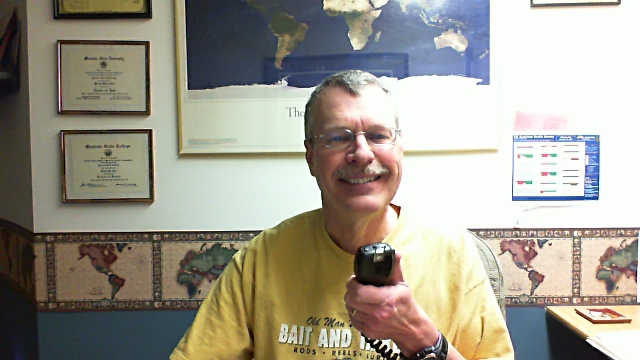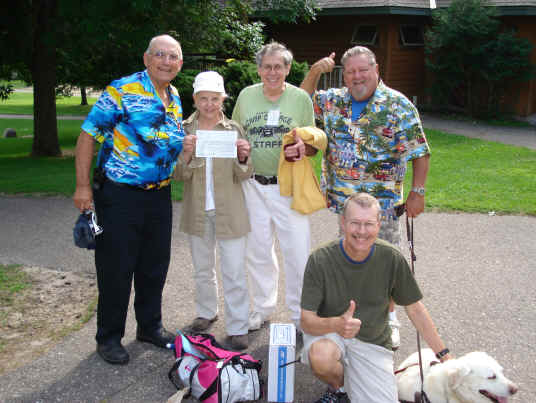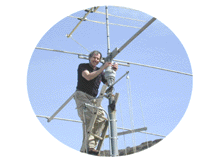Welcome to Handiham World!

Photo: Where's the antenna? Believe it of not, there is a "W0OXB Special" antenna in this photo, and it tunes 160 meters through 6 meters! There are a lot of trees on the property, so hanging the antenna was not a problem. The foliage also confuses the eye and effectively hides the wire antenna, which is in excess of 200 feet long and fed with 450 Ohm ladder line to a 4:1 current balun. If you look closely, you will see the feedline just to the left of the guy standing on the garage roof.
Last Saturday I had fun participating in a good old-fashioned "antenna party". These antenna raising projects are loosely coordinated through our local radio club, and I hadn't been along on one for quite some time. We had plenty of help, but as the old saying goes, "many hands make light work". It was certainly instructive to help, and I learned more about how to launch wires and pull them high up into the tree branches, how to use a guide rope to pull the center insulator and feedline away from branches, and especially the detail work on the center insulator strain relief and weather sealing. One tip from Dave, W0OXB: If you use high quality UV-resistant rope to tie off the ends of the antenna, there is really no need for end insulators. Putting on end insulators is just asking for them to get stuck in the tree branches.
Anyway, this story isn't really about the antenna party. It's about the final result, which (for those of you who can see the photo) is an all but completely invisible wire antenna capable of operating on the HF bands, including 160 meters! The QTH sporting the new antenna is on a corner lot, and the antenna runs diagonally across it, supported by mature trees. The 450 Ohm ladder line comes down from the center of the antenna, angling over the single-story garage's roof and to a current balun mounted on the soffit of the house, somewhat protected from the weather. Although this kind of feedline would be painfully obvious, coming as it does down from a point over the front yard, a clump of birch trees effectively hides it from anyone but the most determined observer. The result is an excellent, versatile antenna that can be used on multiple bands without being an eyesore.
The single biggest obstacle to effective HF operation today is the difficulty many amateur radio operators have getting an antenna up in the air! If only it were as simple as just ordering an antenna and installing it... But it isn't easy at all. There are antenna restrictions of all sorts, and they are not all formal regulations, either. The restrictions that get the most attention in the amateur radio media are those that are codified in municipal ordinances or that are part of homeowner association covenants. The ARRL offers resources on working through such restrictions, and each instance is likely to be somewhat unique.
There are other, but no less real, obstacles to getting an HF antenna up. Consider these:
| Aesthetics. The antenna will be unsightly. Yes, you and I know that a good antenna is a thing of beauty, but your spouse and neighbors may not like seeing that monstrosity in the blue sky above your ham shack. This is an especially relevant concern these days when traditional TV antennas have pretty much disappeared because of TV cable and small satellite TV dish antennas. The TV antenna free clean look of the typical suburban roofline makes that HF antenna stick out like a sore thumb! | |
| Power lines! They run where they run, and that is often exactly in the wrong place when HF antenna installation is concerned. Older neighborhoods typically have lines running along alleyways at the rear or side of a property. Power lines might also line the street in front of the house. The "drop" from the main power pole to the house sometimes crosses large sections of the property. You cannot safely run wire antennas above or below power lines, and running your antenna parallel to a power line may result in a higher than average interference from power line noise. | |
| No antenna supports. Your lot may just not have any natural place to support a wire antenna. The trees may be too small or in the wrong places. | |
| Budget! Your budget may not be generous enough to have a tower in the back yard. Like it or not, you may have to make do with less. | |
| Space. Actually, it's the lack thereof! Most city lots are a challenge when you are talking about getting wire antennas up for bands like 160 and 75 meters, but some are really, really small. |
Well, what are the options? Before deciding on your own, it might be best to get another opinion. That's part of the process for my club's "MAP", or "Member Assistance Program". We didn't all just show up at the guy's house last Saturday with a bunch of wire and tools. Prior to the antenna party, a separate "antenna assessment" had been done. This is usually completed weeks before the actual installation, and it involves a visit by a knowledgeable team leader. The MAP team leader will walk through the property, measuring the distances between likely antenna supports and planning different installation scenarios. If the situation is hopeless, you might as well find it out from someone who will have other ideas and be able to offer you some alternatives. You might be surprised at how you really can fit an antenna into the space available, but without the practiced eye of the team leader you might have never known.
Vertical antennas can fit in small spaces and when positioned in the back yard can also be invisible from the street in front. Most designs do require at least some radials, but a few don't. You might consider one of the new 43 foot verticals fed with a current balun at the base. I see in the September QST that LDG now has one for under $200. This antenna design, available from LDG and other companies, allows you to operate on 80 through 6 meters with one antenna. True, you will not get on the "top band" (160 m), but you will have good coverage on the other bands and will be able to make use of most bands on your HF radio. If a wire antenna won't fit, a vertical might.
Sometimes there are just no options outdoors, but an attic antenna might be possible. These are generally good for 14 MHz and above, because there will not be enough space to fit antennas for the lower frequencies in an attic space. I really don't like attic antennas much, because they are often hard to install in unfinished attic spaces. The space may be cramped and unlighted, and you may need to step carefully on rafters so as not to put your foot through the ceiling below. Running feed lines can also be challenging. Attic antennas are most suited to digital low power operation, such as QRP CW or PSK-31.
Mobile or portable operation might be viable choices. There are small antennas designed for backpacking into the wilderness - you might be able to operate with one of them set up in whatever space you have available, even at home. Be prepared for some difficult copy and some tough times breaking pileups, though. These are not the most efficient antennas, and because they usually are inductively loaded, they have narrow - almost single frequency - bandwidth without tuning. One special type of portable antenna is the simple end-fed wire. It can be thrown up into a tree at a campsite and tuned with an antenna tuner. Some tuners are automatic and match a wide variety of antennas. Mobile antennas suffer from the same limitations. They are physically short and have very sharp tuning. They are also not terribly efficient. Still, they can offer you a way to get on the air.
Remote base operation is an option for Handiham members with computers with Microsoft Windows® and high-speed internet. Sometimes a mixture of operation from a home station and a remote base station is the way to go. For example, you may have room for an antenna that operates on 14 MHz and above, but not enough room for a wire antenna that would be effective on 3.9 MHz. To get on that 75 meter net you like, you can then use either of the W0ZSW or W0EQO remote base stations. The remotes are a Handiham member service. Both stations have excellent wire antennas and are located in RF-quiet areas.
I guess the point is that you can get on the HF bands one way or the other. Getting help while assessing your antenna situation is a good first step. Even if your local club does not have a member assistance program, you can still speak up at the club meeting and ask if there might be any volunteers who might know about antennas and who could help you decide how to best use your available space. If stealth is an issue and you need to camouflage the antenna, the club members will usually have some ideas and suggestions. Just don't give up! If you want to get on the HF bands, there is a way to do it.
For Handiham World, I'm...




